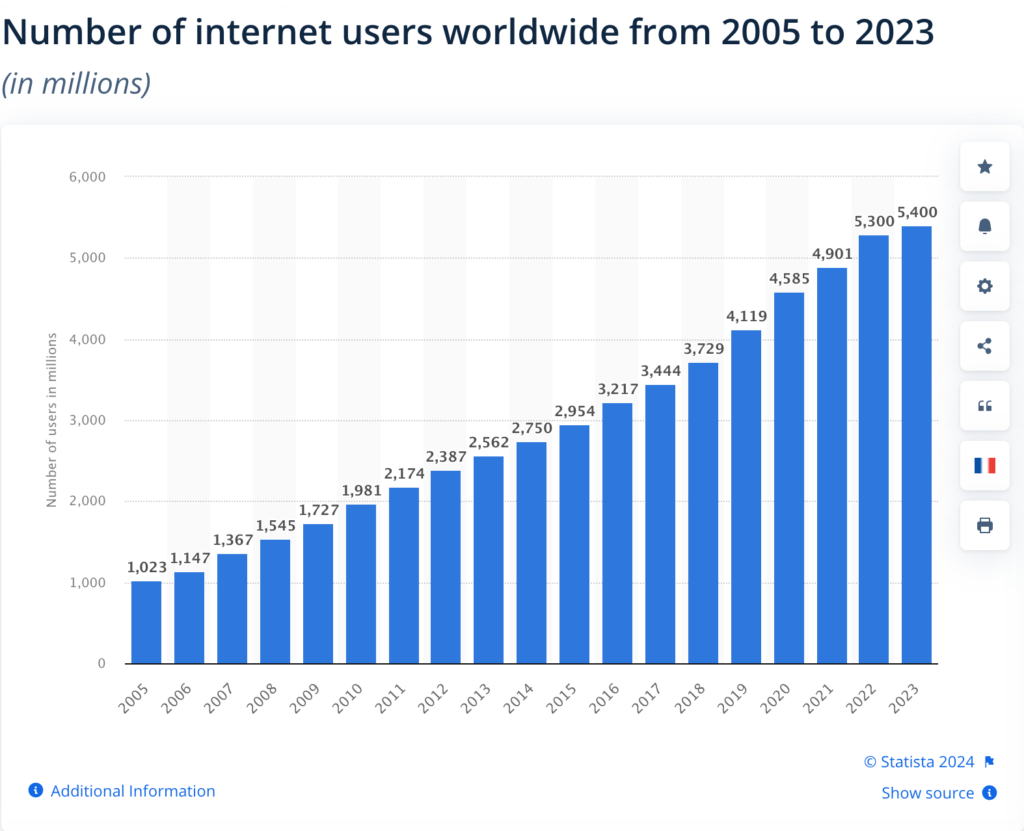
With the drive towards net zero emissions, many UK businesses are conscious of reducing their carbon footprint. But something with surprisingly high emissions, and often forgotten about, is their digital carbon footprint.
Think about the internet, and you’d be forgiven for believing it only has a tiny impact on the environment. But, astonishingly, the internet produces more emissions than the aviation industry. Research estimates that by 2025, the IT industry could be using 20% of all electricity produced and emit up to 5.5% of global emissions.
The emissions behind manufacturing and shipping hardware (computers, smartphones, servers) makes some sense. The more shocking part is the huge amount of energy needed for data storage and usage.
Two thirds of the global population (5.44 billion) are internet users. That figure is predicted to rise to 7.3 billion by 2029.

Over recent years, we’ve seen an increased demand for online content. Storing files and photographs on the cloud has grown. Films, music, and gaming have all developed into online streaming models. We listen to podcasts, download data, and stream videos.
If it’s all online, there’s no obvious dirty factory pumping out pollution. But the more things that move online, the more data that needs storing. The more data we store, the more energy is needed to power and cool that storage.
When our data is stored on the cloud, it’s not somewhere in the ether – it’s on servers in huge data centres. Every action taken on the internet goes through a server. The same with storing and recovering files.
These servers need buildings and electricity to store and transmit the data, plus cooling systems to prevent overheating. Think about how warm a normal computer gets during the day, then consider a giant building full of digital things happening. The servers need cooling, and that means water and air conditioning (using electricity).
Many data centres are still run on fossil fuels too making the internet the largest coal-powered machine on the planet.
The USA has the highest number of data centres. But China has the largest data centre in the world, covering more than 233 football pitches.
It’s not just cloud storage and data centres though.
Our throw away society means more electronic waste. Manufacturing new phones, cables, computers, and routers contribute to the carbon footprint. Installing and running IT services contribute too.
Searching online, streaming services, and video calling all use energy. An average of 3.5 billion Google searches by internet users every day is the equivalent carbon footprint of travelling to the moon seven times.
Spending time on 10 social media platforms for just five minutes every day is the equivalent of driving a car 52.5 miles. More user friendly comparisons of social media carbon footprint can be seen on the website 8billiontrees.
Every document, photo, email, social media post, and comment goes through the internet. That means using computer servers in data centres.
The servers, housed in huge buildings, need electricity to run and systems to cool. So, whenever we click, it’s adding to a land, energy, and water footprint.
It’s not about giving everything up, it’s about quality over quantity.
An estimated 361 billion emails worldwide are sent every day. An email taking ten minutes to write and three minutes to read, sent and received on a laptop, uses 17g of CO2e.
Here’s what to do:
Even though emails contribute to carbon footprint, switching to e-billing where possible will have a lower carbon footprint than receiving physical bills through the mail.
A one hour Zoom call can use between 150 to 1,000g CO2e, but turning off the camera during a video call reduces carbon emissions by up to 96%.
In 2022, Internet Survey Providers reported that around a third of their network traffic was Netflix.
Here’s what to do:
The amount of information we send, receive, and view every day makes it easy to build online clutter. Clearing it periodically is good for our devices, and also reduces our digital footprint.
Here’s what to do:
Reducing the amount of files stored on the cloud will mean a cleaner computer, cleaner energy, and less land needed for data centres.
Here’s what to do:
In January 2024, Google was processing 5.9 million searches, every minute. Each search takes energy because it’s using multiple servers.
Here’s what to do:
New tech and gadgets have a high environmental cost. Between 75% – 85% of a laptop’s carbon footprint is during the manufacturing phase.
Here’s what to do:
Wireless chargers can use 50% more energy, and plugged in devices can still draw energy even when switched off through vampire power. Even in sleep mode, computers burn energy – nearly a quarter of all residential energy consumed is on devices in idle power mode.
Here’s what to do:
Making your website greener will have a positive impact on the user experience and for search engine optimisation.
Here’s what to do:
Every click on a website has an environmental impact through data requests from servers. Simplifying the structure can reduce emissions and give readers a better experience.
Here’s what to do:
Awareness of digital carbon footprints has grown in recent years. Small businesses may not feel that they can make much impact – but small changes add up to big differences.
Some big brands in the IT sector are already committing to being 100% renewable, and that includes their carbon footprint.
Using renewable energy can make the internet cleaner in your business. But by learning how to make your digital impact greener, you can improve your business too.
To chat about reducing the carbon footprint of your business, please get in touch:
Net Zero Barnsley is part of the Low Carbon Project, a project part-funded by the UK Government through the UK Shared Prosperity Fund. Sheffield City Council is the accountable body for the South Yorkshire region. The Low Carbon project has received £3,445,606 from the UK Government through the UK Shared Prosperity Fund. The UK Shared Prosperity Fund is a central pillar of the UK Government’s Levelling Up agenda and provides £2.6 billion of funding for investment by March 2025. The Fund aims to improve pride in place and increase life chances across the UK, investing in communities and place, supporting local business, and people and skills. For more information, visit https://www.gov.uk/government/publications/uk-shared-prosperity-fund-prospectus